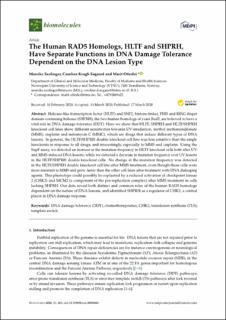| dc.contributor.author | Otterlei, Marit | |
| dc.contributor.author | Seelinger, Mareike | |
| dc.contributor.author | Søgaard, Caroline Krogh | |
| dc.date.accessioned | 2020-04-23T11:47:19Z | |
| dc.date.available | 2020-04-23T11:47:19Z | |
| dc.date.created | 2020-04-22T10:18:56Z | |
| dc.date.issued | 2020 | |
| dc.identifier.citation | Biomolecules. 2020, 10 (3) | en_US |
| dc.identifier.issn | 2218-273X | |
| dc.identifier.uri | https://hdl.handle.net/11250/2652230 | |
| dc.description.abstract | Helicase-like transcription factor (HLTF) and SNF2, histone-linker, PHD and RING finger domain-containing helicase (SHPRH), the two human homologs of yeast Rad5, are believed to have a vital role in DNA damage tolerance (DDT). Here we show that HLTF, SHPRH and HLTF/SHPRH knockout cell lines show different sensitivities towards UV-irradiation, methyl methanesulfonate (MMS), cisplatin and mitomycin C (MMC), which are drugs that induce different types of DNA lesions. In general, the HLTF/SHPRH double knockout cell line was less sensitive than the single knockouts in response to all drugs, and interestingly, especially to MMS and cisplatin. Using the SupF assay, we detected an increase in the mutation frequency in HLTF knockout cells both after UV- and MMS-induced DNA lesions, while we detected a decrease in mutation frequency over UV lesions in the HLTF/SHPRH double knockout cells. No change in the mutation frequency was detected in the HLTF/SHPRH double knockout cell line after MMS treatment, even though these cells were more resistant to MMS and grew faster than the other cell lines after treatment with DNA damaging agents. This phenotype could possibly be explained by a reduced activation of checkpoint kinase 2 (CHK2) and MCM2 (a component of the pre-replication complex) after MMS treatment in cells lacking SHPRH. Our data reveal both distinct and common roles of the human RAD5 homologs dependent on the nature of DNA lesions, and identified SHPRH as a regulator of CHK2, a central player in DNA damage response. | en_US |
| dc.language.iso | eng | en_US |
| dc.publisher | MDPI | en_US |
| dc.rights | Navngivelse 4.0 Internasjonal | * |
| dc.rights.uri | http://creativecommons.org/licenses/by/4.0/deed.no | * |
| dc.title | The human RAD5 homologs, HLTF and SHPRH, have separate functions in DNA damage tolerance dependent on the DNA lesion type | en_US |
| dc.type | Peer reviewed | en_US |
| dc.type | Journal article | en_US |
| dc.description.version | publishedVersion | en_US |
| dc.source.volume | 10 | en_US |
| dc.source.journal | Biomolecules | en_US |
| dc.source.issue | 3 | en_US |
| dc.identifier.doi | 10.3390/biom10030463 | |
| dc.identifier.cristin | 1807474 | |
| dc.description.localcode | This is an open access article distributed under the Creative Commons Attribution License which permits unrestricted use, distribution, and reproduction in any medium, provided the original work is properly cited | en_US |
| cristin.ispublished | true | |
| cristin.fulltext | original | |
| cristin.qualitycode | 1 | |

